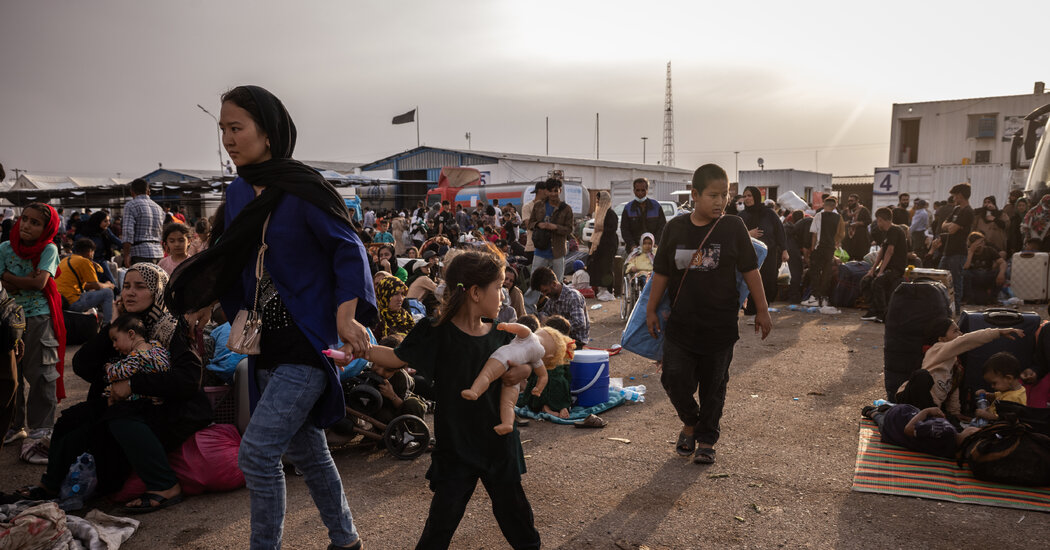No more evening walks. No more jobs at the supermarket. No more hopes for school.
As three Afghan sisters returned to Afghanistan after being deported from Iran last week, the reality of what they had once enjoyed and was now out of reach sank in amid their sighs and dwindling claims of defiance.
Marwa, 18, noted they should start by getting head scarves and outfits to cover themselves, which they didn’t have.
“Afghanistan is like a cage for women, and we’re coming back to that cage,” said Khurshid, 17, the youngest of the three and a self-taught painter.
Iran’s mass deportation of more than 1.4 million Afghans this year has shattered the hopes of women and girls working and studying in Iran. Neighboring Pakistan has implemented a similar policy, putting at risk the lives of many other women who fled Afghanistan in the wake of the Taliban takeover in 2021.
Some of the world’s most severe restrictions on women and girls await. Under the new Afghan government, it is against the law for girls to study beyond sixth grade. Women cannot hold most jobs or go to public spaces like parks, nor travel long distances without a male companion.
In recent months a growing number of single women, female-headed households and unaccompanied minors have been deported or forced to return from Iran, according to half a dozen humanitarian workers, mental health counselors and migration officers in Afghanistan.
They include 15-year-old girls split from their parents and deported on their own; wives traveling on their own as their husbands hide in Iran and try to keep jobs; and single mothers struggling to speak about the police beatings or sexual abuse they faced at the hands of Iranian landlords and employers.
“The needs are very high for gender-based violence and mental health, and our resources very limited,” said Sunita, who works near the border for a humanitarian agency. She asked, like most women who spoke for this article, to be identified by one name for safety reasons.
Upon the women’s return to western Afghanistan, social workers have tried to prepare teenagers and women who were born in Iran or lived there for years about the restrictions they would face.
Khurshid arrived in Afghanistan, at the Islam Qala border crossing, wearing torn denim overalls and trendy sneakers. She said she draws her style from an Iranian influencer and an Afghan celebrity living in Dubai whom she follows on TikTok.
When Taliban guards overseeing the relocation facility in Islam Qala commanded Khurshid to wear a hijab last week, she rejected the orders, telling them, “I like the way I am.” . Marwa acknowledged that the sisters, including the eldest, Behishta, 19, would have to buy head scarves and head-to-toe outfits to cover their bodies.
Across the facility, which has accommodated, on average, more than 20,000 Afghans returning every day, some women defied Taliban-imposed restrictions by polishing their nails or smoking e-cigarettes in the open.
“They don’t know what they’re coming back to,” said Ferishteh, an aid worker in western Afghanistan.
“We’re telling them, ‘The way you dress isn’t good for here, get ready for what awaits you, get ready to cope,’” she said.
“We’re not happy to tell them that, but we have to, for their own protection,” she added, citing the need to relocate them, provide emergency money and reunite single women with relatives as the most urgent priorities.
Still, many women and girls said they felt relieved to be back in Afghanistan after facing unchecked xenophobia in Iran. The mother of a 10-month-old toddler said pharmacies had refused to sell her baby milk powder because she was Afghan. Another said four hospitals turned her away when she brought in her 19-year-old son for surgery after two Iranian men slashed his hand open with a knife while shouting “dirty Afghan.”
For women who were working in Iran, job opportunities will be scarce. Seven percent of Afghan women were employed outside their homes as of last year, according to the United Nations Development Program.
Shabnam Ashrafi, who planted apricot trees in an orchard and packed tomatoes and cucumbers in northern Iran, said she didn’t know how her household would cope with the loss of her monthly income of $130. “Being the only breadwinner adds some pressure,” her husband, Amrullah, said one evening last week as they waited to board a bus that would take them to Kabul, the Afghan capital, from the relocation facility in Islam Qala.
Their 13-year-old daughter, Shamila, stood in silence behind them. She had just completed sixth grade in Iran when the family was arrested. Her mother said that Shamila’s and her younger sister’s education had been one of the main drivers behind their move to Iran after the Taliban takeover in 2021.
“She’s asked me, ‘What have all these years been for?’” Ms. Ashrafi said. “We only cared about our children’s education, but here we are now, and I don’t know what to tell her.”
Yaqoob Akbary contributed reporting.
Elian Peltier is The Times’ West Africa correspondent, based in Dakar, Senegal.
The post Afghan Women and Girls Deported From Iran Fear ‘Coming Back to a Cage’ appeared first on New York Times.




